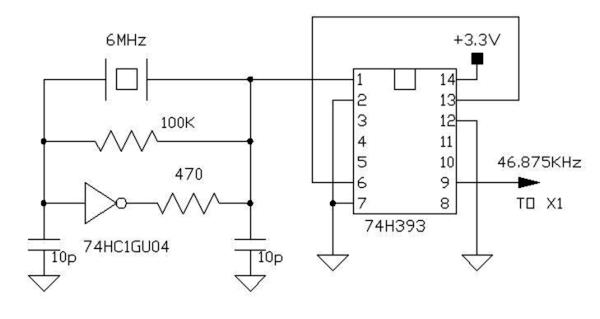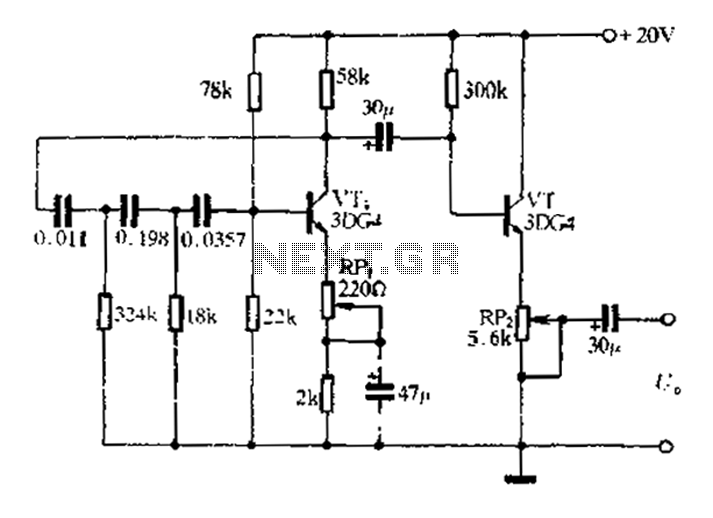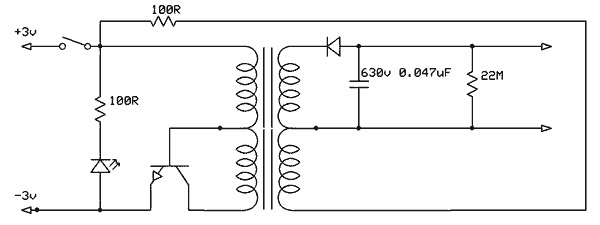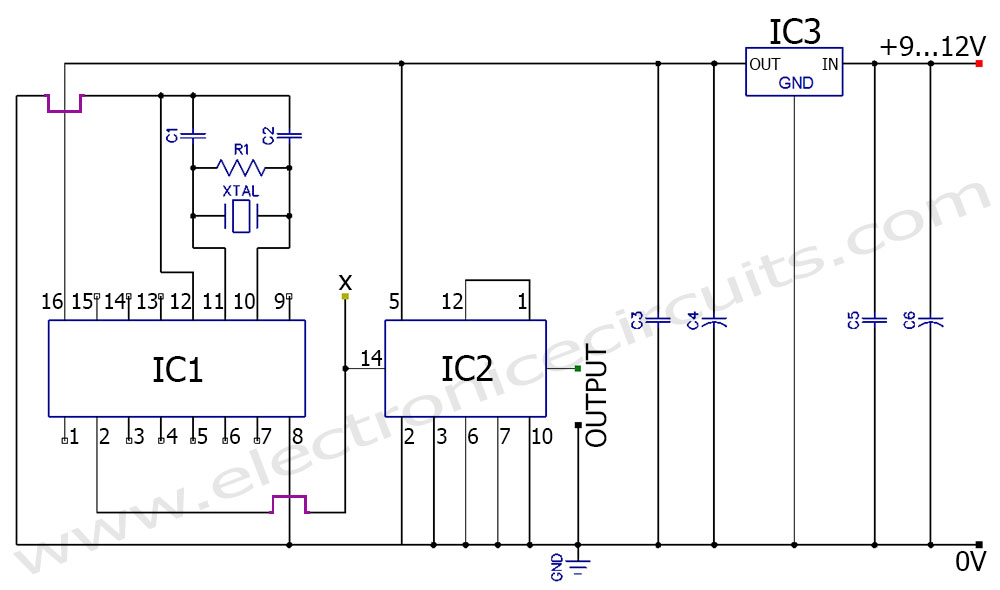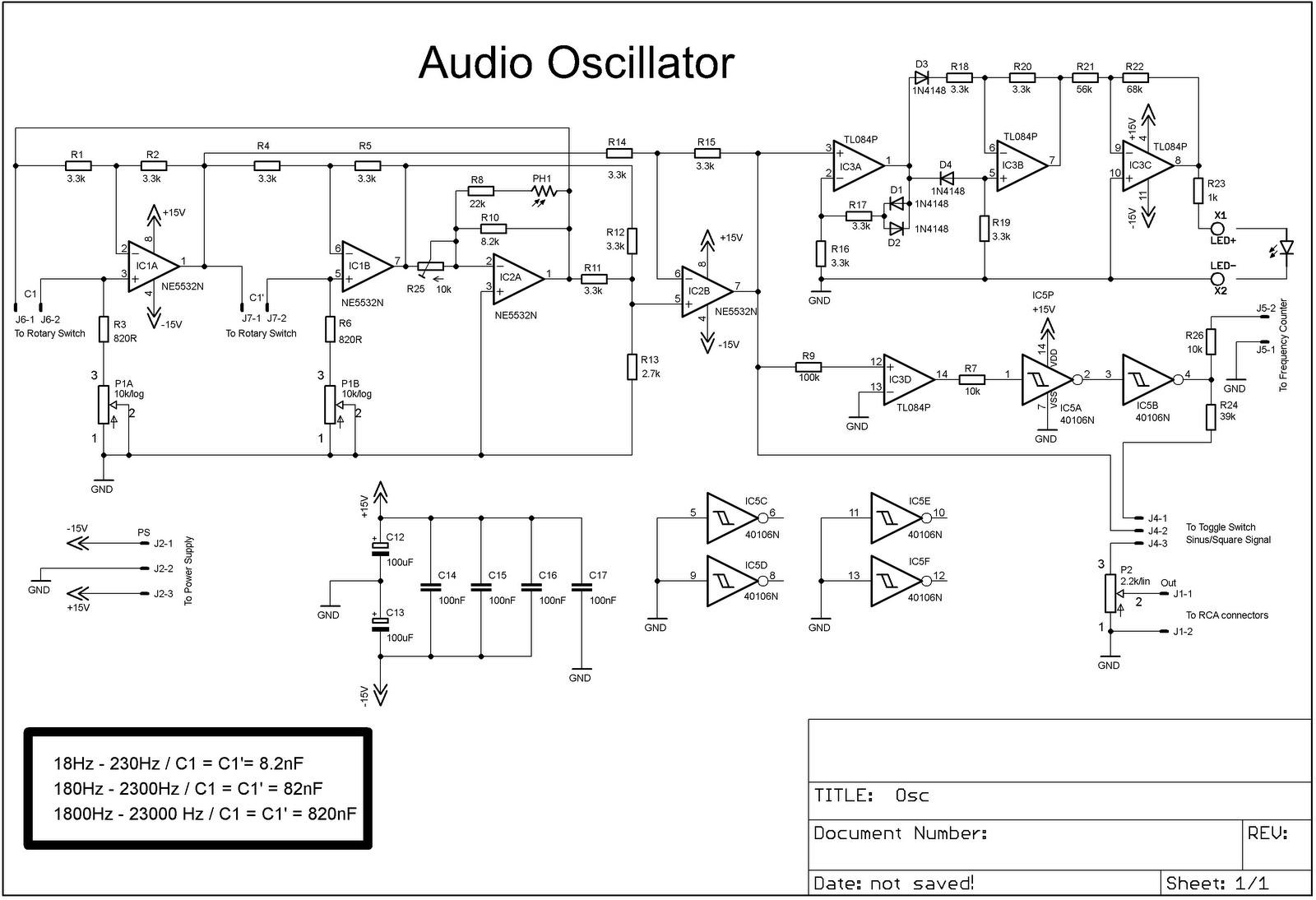
Wien-Bridge Oscillator
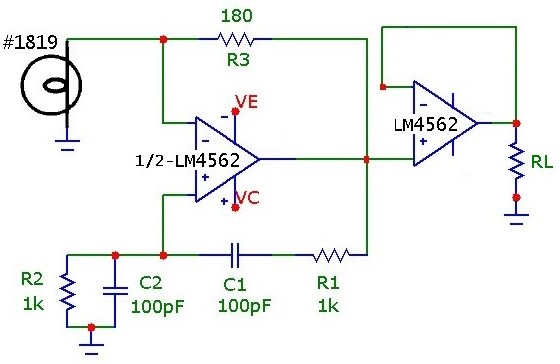
The classic Wien-Bridge oscillator, with incandescent lamp nonlinear stabilization, provides a low distortion sine wave source. A thorough and clear discussion of the Wien-Bridge oscillator is provided in Malvino's Electronic Principles. Using an inexpensive op-amp with sufficient bandwidth and slew rate, it is possible to adjust the oscillation frequency of this classic circuit into the MHz range. The following simple circuit demonstrates a 1.27 MHz Wien-Bridge oscillator. Although intended for use in ultra-low noise/distortion premium audio applications, the National LM4562 op-amp has sufficient bandwidth, slew rate (GBW: 55 MHz, SLR: 20 V/μs), and output drive capability to provide decent MHz signal oscillation. At 1 MHz, to stay within the slew-rate limit, the circuit must be designed with an oscillation amplitude of less than 2 Vp. This can be achieved by proper selection of the incandescent lamp and feedback resistor. At the oscillation frequency, determined by the lead-lag network feedback transmission peak, the lamp resistance must be exactly half the feedback resistance. The lamp resistance, which increases with voltage, is determined by the RMS voltage across the lamp, so the voltage feedback network must satisfy this condition. It is useful to measure the DC resistance versus voltage of the lamp. The values must also be within the current drive capability of the selected op-amp. Additionally, the output signal peak amplitude must be within the voltage range capability for the available Vcc/Vee supply. These conditions can be easily satisfied with proper planning. In this example, a #1819 lamp, nominally 28 V @ 40 mA, was used. Using standard resistor values, an Rf of 180 ohms provides output oscillation at 1.27 MHz with a 1.35 Vp amplitude, within the slew-rate limit. With a supply voltage of ±3.0 V, the LM4562 can operate within 0.5 V of the rails, allowing the circuit to be conveniently powered using 4 AA cells as a split supply. The protoboard layout and overall test configuration are shown, powered by a split 8 AA supply, although it functions identically with a ±3.0 V supply. The circuit oscillates at 1.27 MHz, demonstrating stability at this relatively high frequency. The frequency discrepancy is attributed to non-ideal op-amp effects, which shift the oscillation condition from the ideal zero-degree phase shift point of the lead-lag network, thus lowering the oscillation frequency. Since the negative feedback loop resistance is low, the op-amp's drive capability and output resistance will also shift the operating point. Using lamps with higher resistance values (e.g., #80, 327, 344, 1869, 2158, 7218 lamps) will provide greater feedback resistance and less current consumption. However, in the current circuit, the output signal current draw is low by design at about 5 mA, well within the op-amp's drive capability. The LM4562 is a dual op-amp, enabling the Wien-Bridge to be easily coupled to a unity-gain buffer. In this configuration, a stable 1.27 MHz test signal circuit can be implemented. The circuit was tested under different loads (RL), with the output amplitude and frequency remaining constant (Vout = 1.35 ± 0.01 Vp, f = 1.27 ± 0.005 MHz) down to loads as low as 50 ohms (at which point the output current draw is Ip = 27 mA, roughly the limit of this op-amp). Furthermore, this op-amp can drive capacitive loads as high as 100 pF. With a 50-ohm resistive load and a 3 ft. RG-58U test cable terminated into a 1 MΩ scope input (about 100 pF shunt capacitance), the 1.27 MHz output remained unchanged. This circuit can be adapted, with modifications to the lead/lag network values, to generate extremely low distortion test audio signals in the 100 Hz to 20 kHz audio range, as well as ultrasonic signals in the hundreds of kHz range.
The Wien-Bridge oscillator is a well-known circuit configuration that utilizes the principles of feedback and phase shift to generate sinusoidal waveforms. In this implementation, the use of an incandescent lamp as a nonlinear feedback element introduces a variable resistance that stabilizes the oscillations. As the amplitude of the output signal increases, the lamp's resistance increases, effectively reducing the gain of the feedback loop and preventing the circuit from saturating.
The circuit's design relies on the careful selection of components, particularly the op-amp and the lamp, to ensure that the oscillation frequency remains stable and within the desired range. The LM4562 op-amp is particularly well-suited for this application due to its high gain bandwidth product and fast slew rate, which are essential for generating high-frequency signals with low distortion.
The lead-lag network, which is critical in determining the oscillation frequency, is composed of resistors and capacitors that create the necessary phase shift for sustained oscillation. The precise values of these components must be calculated to achieve the desired frequency while maintaining the stability of the circuit.
In practical applications, the circuit can be tested and verified with various loads to ensure that it meets performance specifications. The ability of the LM4562 to drive capacitive loads and maintain output amplitude under varying conditions is a significant advantage, making it suitable for a range of audio and signal generation applications.
By modifying the feedback network, users can tailor the oscillator's output to suit specific requirements, whether for audio testing or other signal generation tasks, demonstrating the versatility and effectiveness of the Wien-Bridge oscillator design.The classic Wien-Bridge oscillator, with incandescent lamp nonlinear stabilization, provides a low distortion sine wave source. A thorough and clear discussion of the Wien-Bridge oscillator is provided in Malvino`s Electronic Principles.
Using an inexpensive opamp with sufficient bandwidth and slew-rate, it is possible to nudge the oscillation fre quency of this classic circuit into the MHz range. The following simple circuit demonstrates a 1. 27 MHz Wien-Bridge oscillator. Although intended for use in ultra low noise/distortion premium audio applications, the National LM4562 opamp has sufficient bandwidth, slew rate (GBW: 55 MHz, SLR: 20 V/us) and output drive capability to provide decent MHz signal oscillation. At 1 MHz, in order to stay within the slew-rate limit, the circuit must be designed with an oscillation amplitude of less than 2Vp.
This can be achieved by proper selection of the incandescent lamp and feedback resistor. At the oscillation frequency, determined by the lead-lag network feedback transmission peak, the lamp resistance must be exactly half the feedback resistance. The lamp resistance, which increases with voltage, is determined by the RMS voltage across the lamp, so the voltage feedback network must satisfy this condition.
(As a guideline, it is useful to measure the DC resistance versus voltage of the lamp). Also the values must be within the current drive capability of the selected opamp. In addition, the output signal peak amplitude must be within the voltage range capability for the available Vcc/Vee supply. Fortunately, these conditions are easily satisfied with a little planning. In this example a #1819 lamp, nominally 28 V @ 40 mA was used. Using standard resistor values, an Rf of 180 ohm provides output oscillation at 1. 27 MHz with 1. 35 Vp amplitude, within the slew-rate limit. With a supply voltage of +_3. 0V, the LM4562 can operate within 0. 5V of the rails, and so the circuit can be conveniently powered using 4-AA cells as a split supply. The protoboard layout and overall test configuration are shown below (in this case powered by a split 8-AA supply although it does function identically with +_3.
0 V supply). The circuit oscillates at 1. 27 MHz as shown below, and is quite stable even at this relatively high frequency. The discrepancy in frequency is due to non-ideal opamp effects (discussed below) which shift the oscillation condition from the ideal zero-degree phase shift point of the lead-lag network and thus pulling the oscillation frequency to lower values. Since the negative feedback loop resistance is rather low, the drive capability of the opamp and output resistance will also shift the operating point.
Use of lamps with higher resistance values (e. g. #80, 327, 344, 1869, 2158, 7218 lamps) will provide greater feedback resistance and less current consumption, although in the present circuit, the output signal current draw is low by design at about 5 mA, well within the drive capability of the opamp. The LM4562 is a dual opamp so the Wien-Bridge can be easily coupled to a unity-gain buffer. In this configuration, a rock solid 1. 27 MHz test signal circuit can be implemented. The circuit below was tested under different loads RL, and the output amplitude and frequency were constant (Vout=1.
35 +-0. 01 Vp, f= 1. 27 +_0. 005 MHz) down to loads as low as and including 50 ohm (at which point the output current draw is Ip = 27 mA. roughly the limit of this opamp). Futhermore, this opamp can drive capacitative loads as high as 100 pF. With a 50 ohm resistive load AND a 3 ft. RG-58U test cable terminated into a 1 Mohm scope input (about 100 pF shunt capacitance), the 1. 27 MHz was unchanged. The circuit can obviously be used, with change of lead/lag network values, to generate extremely low distortion test audio signals in the 100 Hz to 20 kHz audio range as well as ultrasonic signals in the hundreds of kHz range.
It would be int 🔗 External reference
The Wien-Bridge oscillator is a well-known circuit configuration that utilizes the principles of feedback and phase shift to generate sinusoidal waveforms. In this implementation, the use of an incandescent lamp as a nonlinear feedback element introduces a variable resistance that stabilizes the oscillations. As the amplitude of the output signal increases, the lamp's resistance increases, effectively reducing the gain of the feedback loop and preventing the circuit from saturating.
The circuit's design relies on the careful selection of components, particularly the op-amp and the lamp, to ensure that the oscillation frequency remains stable and within the desired range. The LM4562 op-amp is particularly well-suited for this application due to its high gain bandwidth product and fast slew rate, which are essential for generating high-frequency signals with low distortion.
The lead-lag network, which is critical in determining the oscillation frequency, is composed of resistors and capacitors that create the necessary phase shift for sustained oscillation. The precise values of these components must be calculated to achieve the desired frequency while maintaining the stability of the circuit.
In practical applications, the circuit can be tested and verified with various loads to ensure that it meets performance specifications. The ability of the LM4562 to drive capacitive loads and maintain output amplitude under varying conditions is a significant advantage, making it suitable for a range of audio and signal generation applications.
By modifying the feedback network, users can tailor the oscillator's output to suit specific requirements, whether for audio testing or other signal generation tasks, demonstrating the versatility and effectiveness of the Wien-Bridge oscillator design.The classic Wien-Bridge oscillator, with incandescent lamp nonlinear stabilization, provides a low distortion sine wave source. A thorough and clear discussion of the Wien-Bridge oscillator is provided in Malvino`s Electronic Principles.
Using an inexpensive opamp with sufficient bandwidth and slew-rate, it is possible to nudge the oscillation fre quency of this classic circuit into the MHz range. The following simple circuit demonstrates a 1. 27 MHz Wien-Bridge oscillator. Although intended for use in ultra low noise/distortion premium audio applications, the National LM4562 opamp has sufficient bandwidth, slew rate (GBW: 55 MHz, SLR: 20 V/us) and output drive capability to provide decent MHz signal oscillation. At 1 MHz, in order to stay within the slew-rate limit, the circuit must be designed with an oscillation amplitude of less than 2Vp.
This can be achieved by proper selection of the incandescent lamp and feedback resistor. At the oscillation frequency, determined by the lead-lag network feedback transmission peak, the lamp resistance must be exactly half the feedback resistance. The lamp resistance, which increases with voltage, is determined by the RMS voltage across the lamp, so the voltage feedback network must satisfy this condition.
(As a guideline, it is useful to measure the DC resistance versus voltage of the lamp). Also the values must be within the current drive capability of the selected opamp. In addition, the output signal peak amplitude must be within the voltage range capability for the available Vcc/Vee supply. Fortunately, these conditions are easily satisfied with a little planning. In this example a #1819 lamp, nominally 28 V @ 40 mA was used. Using standard resistor values, an Rf of 180 ohm provides output oscillation at 1. 27 MHz with 1. 35 Vp amplitude, within the slew-rate limit. With a supply voltage of +_3. 0V, the LM4562 can operate within 0. 5V of the rails, and so the circuit can be conveniently powered using 4-AA cells as a split supply. The protoboard layout and overall test configuration are shown below (in this case powered by a split 8-AA supply although it does function identically with +_3.
0 V supply). The circuit oscillates at 1. 27 MHz as shown below, and is quite stable even at this relatively high frequency. The discrepancy in frequency is due to non-ideal opamp effects (discussed below) which shift the oscillation condition from the ideal zero-degree phase shift point of the lead-lag network and thus pulling the oscillation frequency to lower values. Since the negative feedback loop resistance is rather low, the drive capability of the opamp and output resistance will also shift the operating point.
Use of lamps with higher resistance values (e. g. #80, 327, 344, 1869, 2158, 7218 lamps) will provide greater feedback resistance and less current consumption, although in the present circuit, the output signal current draw is low by design at about 5 mA, well within the drive capability of the opamp. The LM4562 is a dual opamp so the Wien-Bridge can be easily coupled to a unity-gain buffer. In this configuration, a rock solid 1. 27 MHz test signal circuit can be implemented. The circuit below was tested under different loads RL, and the output amplitude and frequency were constant (Vout=1.
35 +-0. 01 Vp, f= 1. 27 +_0. 005 MHz) down to loads as low as and including 50 ohm (at which point the output current draw is Ip = 27 mA. roughly the limit of this opamp). Futhermore, this opamp can drive capacitative loads as high as 100 pF. With a 50 ohm resistive load AND a 3 ft. RG-58U test cable terminated into a 1 Mohm scope input (about 100 pF shunt capacitance), the 1. 27 MHz was unchanged. The circuit can obviously be used, with change of lead/lag network values, to generate extremely low distortion test audio signals in the 100 Hz to 20 kHz audio range as well as ultrasonic signals in the hundreds of kHz range.
It would be int 🔗 External reference
